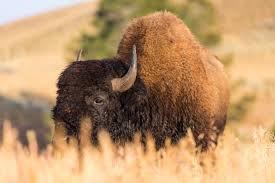
Bison Bull in Yellowstone Park. The visitor rule is to stay at least 25 yards away from buffalo and other large wild animals in the Park. Photo courtesy of NPS, by Neal Herbert.
On the afternoon of May 20, 2020, a female visitor was knocked to the ground and injured by a bison in the Old Faithful Upper Geyser Basin after approaching the animal too closely (inside 25 yards).
It was the first bison injury this year, and happened just two days after Yellowstone National Park reopened in a phased way after the Coronavirus pandemic began.
Park emergency medical providers responded to the incident immediately. The woman was assessed and refused transport to a medical facility. The incident remains under investigation, park officials said in a news release.
The National Park Service personnel remind Park visitors that wildlife in Yellowstone National Park are wild. When an animal is near a trail, boardwalk, parking lot, or in a developed area, they advise giving it space.
“Stay 25 yards (23 m) away from all large animals. This includes bison, elk, bighorn sheep, deer, moose, and coyotes and stay at least 100 yards (91 m) away from bears and wolves,” is the rule.
If need be, visitors need to turn around and go the other way to avoid interacting with a wild animal in close proximity.
The National Park Service advises following these simple rules:
- Never approach animals. The animals in Yellowstone are wild and unpredictable, no matter how calm they appear to be. The safest (and often best) view of wildlife is from inside a car. Always stay at least 100 yards (91 m) away from bears and wolves, and at least 25 yards (23 m) away from all other animals, including bison and elk.
- Stay on boardwalks and trails in thermal areas. Hot springs have injured or killed more people in Yellowstone than any other natural feature. Keep your children close and don’t let them run.
- Never feed wildlife. Animals that become dependent on human food may become aggressive toward people and have to be killed. Keep all food, garbage, or other smelly items packed away when not in use.
- Never park in the road or block traffic. Use pullouts to watch wildlife and let other cars pass. Stay with your vehicle if you encounter a wildlife jam.
“We can’t guarantee your safety in Yellowstone, but these concepts will help you avoid the most common accidents. For more great advice review our Rules & Regulations, Laws & Policies, and tips for backcountry travel. If you have an emergency, dial 911 or notify any park ranger.”
The park staff encourages visitors to take the Yellowstone Pledge: “I pledge to protect Yellowstone National Park. I will act responsibly and safely, set a good example for others, and share my love of the park and all the things that make it special.”
(For more information, search Top 10 ways to put the Yellowstone Pledge into Action.)

Francie M Berg
Author of the Buffalo Tales &Trails blog


